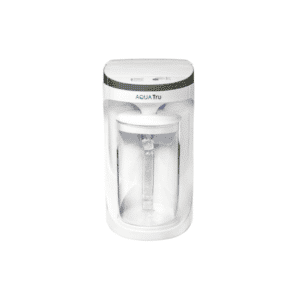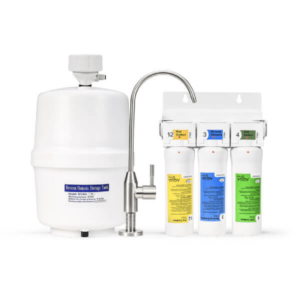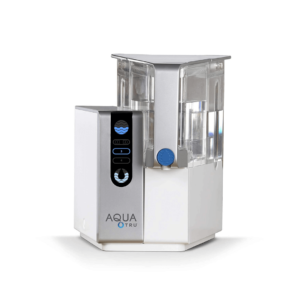Have you ever noticed those “Prop 65” warning labels on some of your favorite products? You know, the ones that caution you about potential exposures to certain chemicals? Well, today we’re diving into this regulation – the good, the bad, and the ugly. Should you worry about Proposition 65 in California? What does this label actually mean? Are there loopholes?
Keep reading to learn more about this regulation. Let’s break it all down!

Note: This article contains affiliate links, meaning In On Around will make a small commission at no additional cost to you. This helps me maintain the site. As always, I value full transparency & only work with brands I love and trust.
What Is California’s Proposition 65?
California’s Proposition 65 (aka “Prop 65“) is part of the Safe Drinking Water and Toxic Enforcement Act that was first enacted in 1986. This is a California ballot initiative that was intended on protecting drinking water and reducing exposure to toxic chemicals, specifically those linked to cancer, birth defects, or other reproductive harms. Even after three decades, this “right-to-know” statute still has a major impact on many industries!
Prop 65 = a “right-to-know” statute
Californian businesses are obliged by law to give a warning to consumers if their products consist of any chemicals listed by the state as being known to cause cancer or reproductive harm, even if the amount of those chemicals present is lower than the safety standards set by the federal government. These safe harbor levels indicate the maximum level of exposure that is considered safe. Prop 65 chemical threshold levels are much lower than federal levels.
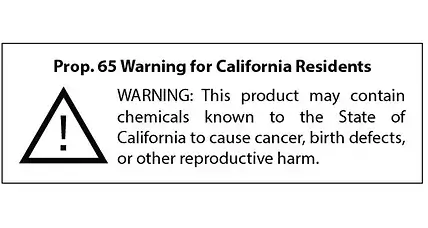
What Products Have Prop 65 Warnings?
The Prop 65 warning label can be present on a wide range of products in California, such as:
- Food products
- Beverages
- Cosmetics
- Furniture
- Clothing
- Electrical wires
- Jewelry
- Dishes
- Flashlights
- Pesticides
- Tobacco products
- Automotive products
- Building materials
- Toys
… and many, many more. This also includes e-commerce products or products sold online. If you don’t comply with the regulation, the company may be liable for fines of up to $2500 per violation per day!
Even service-based businesses must post about it, like bars or dental offices, if there are potentially harmful chemicals used within their walls.
What Classifies A Warning Label?
A Proposition 65 warning label must have the following:
- The URL of OEHHA’s Prop 65 website
- At least one listed chemical name
- Packaging text that’s the same size as the other packaging information (nothing smaller than 6-point font size)
- A triangular warning symbol that has a bold outline with a black exclamation point in the middle
- Next to the triangular symbol, “WARNING” must be listed in bold, capital letters in the same size as the warning symbol
Usually, products with Prop 65 labels made after August of 2018 say something like this:
WARNING: This product can expose you to [name of chemical], which is known to the State of California to cause cancer. For more information, go to www.P65Warnings.ca.gov.
How Many Chemicals Are Listed For Prop 65?
Since its initial publication in 1987, the list of chemicals subject to Proposition 65 has grown to encompass approximately 900 chemicals and the list must be revised at least once a year. In order to get added to the list, the chemicals have to be considered by an “authoritative body” to cause cancer either in humans or lab animals.
Chemicals like lead, cadmium, arsenic, formaldehyde, benzene, acrylamide, asbestos, chromium, toluene, dioxin, and many, many more are on the Prop 65 list.
Authoritative Bodies
The authoritative bodies include:
- International Agency for Research on Cancer (IARC) – part of the World Health Organization (WHO)
- US Environmental Protection Agency (EPA)
- US National Toxicology Program (NTP)
- National Institute for Occupational Safety and Health (NIOSH) – part of the Center for Disease Control (CDC)
- National Cancer Institute (NCI)
- California Environmental Protection Agency (CalEPA)
If you’re looking for the full list of chemicals included under Proposition 65, check out the OEHHA Chemical Database. Learn more about chemicals of concern, like parabens, here: Paraben Safety – Are Parabens In Makeup Harmful?
When Are Labels Required?
Basically, all labels must show a clear and reasonable warning if they expose the user to potential carcinogens.
According to the law, “no significant risk” is described as an amount of exposure that would result in no more than one additional case of cancer in 100,000 people over the course of a 70-year lifespan. If the substance is projected to cause less than that, it does not require Prop 65 labeling. Businesses are responsible for determining whether their products contain any of these chemicals and providing warnings if they do.
As of August 2018, the companies with a warning must specify at least one chemical of concern on the label. They’re NOT required to list every chemical of concern though.
Check Out The In On Around Shop
Who Is Exempt From Prop 65?
First and foremost, if a company’s products are levels below the threshold and their products don’t pose a risk, they’re not required to post a Prop 65 warning label. Companies that have fewer than 10 employees are exempt, likely to protect them from paying for expensive lab testing.
There is also an exception within the regulation for “naturally occurring” chemicals, which you can learn more about in the CA Code of Regulations, Title 27, Section 25501. In order to classify it as naturally occurring, the company must prove that the chemical wasn’t added due to human activity. They must also show that Good Manufacturing Practices couldn’t prevent the naturally occurring chemical from being part of the product.
In addition, any cords that are infrequently plugged and unplugged are exempt from labeling requirements. Any cords that contain lead within their protective covering and those that are located in areas not readily accessible to consumers during normal usage are also exempt from labeling requirements.
Government agencies and public water utilities are also exempt from Prop 65 (… red flag alert). This includes all federal, state, and local government agencies. If this doesn’t encourage you to invest in a high-quality water purifier, I don’t know what will! To learn more about water filters, check out: AquaTru vs. Berkey – What To Look For In A Water Filter or Purifier.
The Pros & Cons Of Prop 65
Let’s dive into the good, the bad, and the ugly! First, the pros:
Pros of Proposition 65
- The regulation encourages the reformulation of products! If companies don’t want to add a warning label, which might deter customers, they can reformulation to use safer ingredients.
- It helps to hold businesses accountable and encourage them to improve the quality of their products.
- Warnings can help educate the population about the potential risks associated with popular brands and products. Consumers have a right to know what’s in the products they’re buying.
- This regulation helps consumers make informed purchasing decisions. Informed consent is crucial!
- Prop 65 is especially helpful if you’re trying to limit your exposure to small, yet compounding, chemical exposures. Small exposures on a daily basis add up over time and can have a significant burden on the body.
- The law has significantly reduced exposure to toxic chemicals. It has certainly impacted the health of hundreds of thousands of Americans in the long-term.
- They’ve especially been successful in reducing chemical air emissions like ethylene oxide and chloroform.

Cons of Proposition 65
- The Prop 65 warning label does not necessarily mean that it’s unsafe
- Levels are typically very, very low and sometimes don’t have a high risk of exposure. For instance, lead inside of a coated electrical cord isn’t typically a risk, unless someone is gnawing on the cord.
- It fails to determine between very big and very small risks. [x]
- Don’t get me wrong, both kinds of risks should be disclosed… but maybe a ranking system would be of more use? It’s nearly impossible to know how severe the risk is.
- It can be seen as overkill by some people. Too many warning labels can make consumers or customers ignore them or get confused. It can sometimes be seen as a “boy who cried wolf” situation.
- Smaller companies can be targeted and sued if they’re non-compliant or were not aware to list a warning label.
- Typically, a Prop 65 lawsuit settlement costs about $65,000. Some exceed a million dollars, depending on the size of the manufacturer or retailer. [x] A lawsuit like this would significantly impact a brand’s financial profile, brand reputation, and customer trust.
- This also puts a lot of money in the pockets of law firms and lawyers who are suing for monetary settlements.
This regulation has caused a LOT of controversies because it has completely changed many industry requirements. Many people claim it’s “meaningless.” I don’t agree.
Final Thoughts – Should You Worry About Prop 65 Warnings?
In my opinion, information is power. Use it accordingly. Proposition 65 labels are meant to inform the consumer. While the labels lack a lot of detail, they can grab the consumer’s attention so they can research what they’re actually purchasing.
If you’re putting the product IN or ON your body, definitely take a closer look at why they have the warning label. Food and personal care items can easily be absorbed by your body. This is especially important for products for babies or children – do your due diligence!
Small exposures add up over time.
If you want to go the extra mile, the best thing to do is to request a 3rd party Certificate of Analysis from the company you’re considering purchasing from. Third-party testing isn’t proprietary information, despite what many brands will claim. If the company is transparent with the quality of its products, that’s a good sign.
⬇ Pin this “Prop 65 Explained?” pic on Pinterest for future reference! ⬇
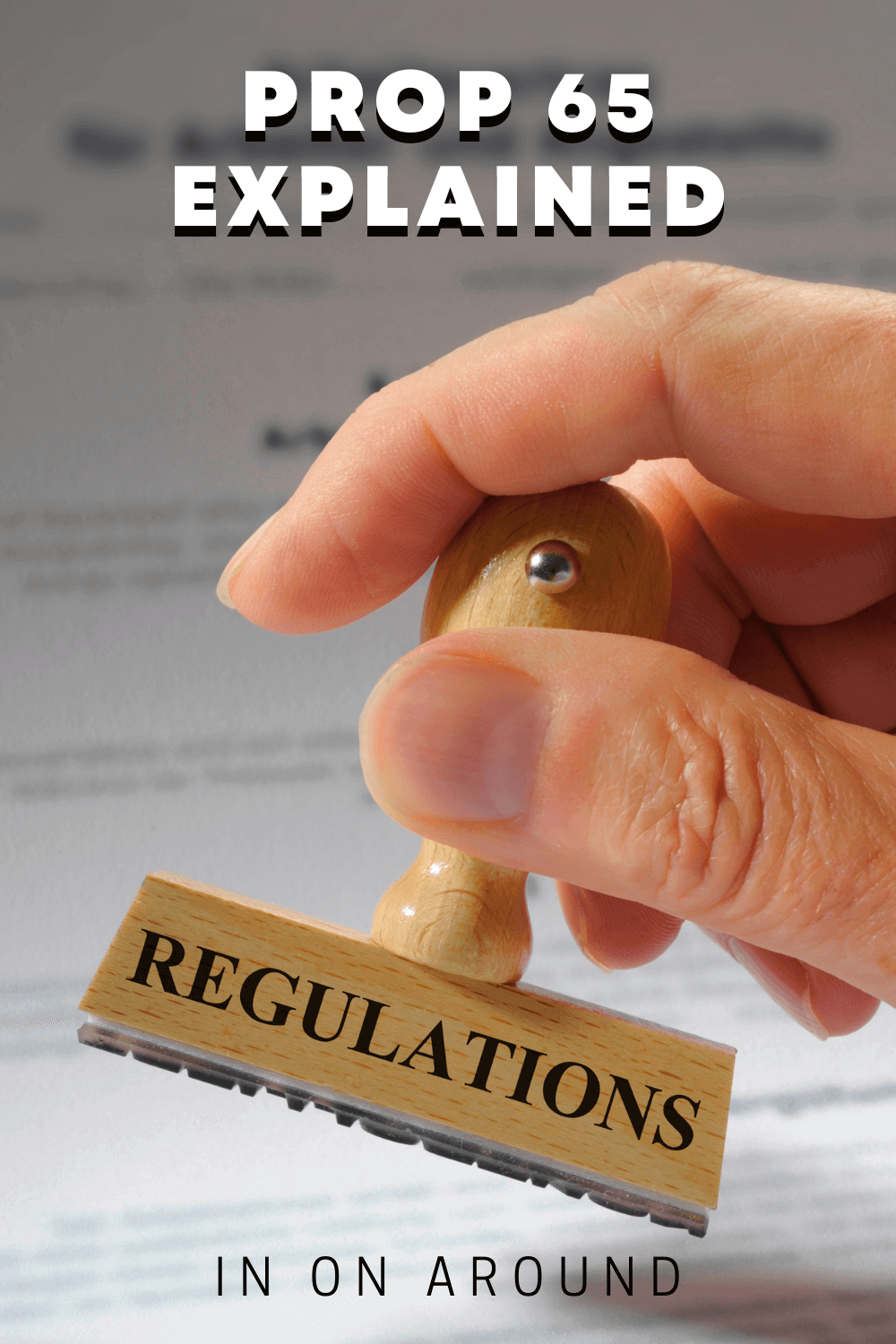
Frequently Asked Questions – Proposition 65 In California
Click on the below FAQs to learn more about proposition 65 in California, safe harbor levels, exemptions, lawsuits, penalties, violations, compliance, and more!
What chemicals are included in California's Prop 65 list?
What are the penalties for violating Prop 65 in California?
Are e-commerce businesses required to comply to Prop 65?
How often is California's Prop 65 list of chemicals updated?
Did you learn something new?
Let me know your thoughts and key takeaways in the comments below!
You can watch our web story here.
xoxo,

Want to read more? Check out my other articles here!
Other references on Proposition 65 in California: Ca.gov, Steel Supplements, American Cancer Society, Consumer Reports, Better Goods, Qima, Plastic Pipe, Eaton, Source Intelligence, Food Safety, OEHHA, P65 Warnings, NY Times
Copyright In On Around LLC 2023 ©. The statements made on this website have not been evaluated by the FDA (U.S. Food & Drug Administration). They are not intended to diagnose, treat, cure, or prevent any disease. The information provided by this website should not be used as individual medical advice and you should always consult your doctor for individual recommendations and treatment. The information contained in this site is provided on an “as is” basis. Related to this site, there are no guarantees of completeness, accuracy, usefulness, or timeliness. In On Around LLC assumes no responsibility or liability for any errors or omissions in the content of this site.

